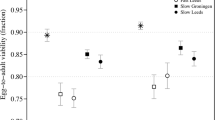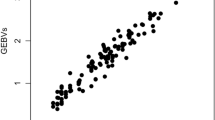Abstract
RYE is normally an outbreeding species. When the plants are forced to inbreed by self-pollination, the progeny, being more homozygous, are, as is usual in such species, less vigorous and less fertile than the heterozygotes which comprise a normal population. Since heterozygotes are superior in this way to the homozygotes, it could be expected that, during the course of inbreeding, natural selection would favour to some extent the more heterozygous genotypes. To test this assumption, we have made use of chromosome structural changes where genotypes heterozygous and homozygous for the chromosome segments involved are easily distinguished.
This is a preview of subscription content, access via your institution
Access options
Subscribe to this journal
Receive 51 print issues and online access
$199.00 per year
only $3.90 per issue
Buy this article
- Purchase on Springer Link
- Instant access to full article PDF
Prices may be subject to local taxes which are calculated during checkout
Similar content being viewed by others
References
Darlington, C. D., and La Cour, L. F., Heredity, 4, 217 (1950).
Dobzhansky, Th., “Genetics and the Origin of Species” (New York 1951).
Smith, M., et al., Proc. Roy. Soc., B, 144, 159 (1955).
White, M. J. D., “Animal Cytology and Evolution” (Camb. Univ Press, 1954).
Author information
Authors and Affiliations
Rights and permissions
About this article
Cite this article
THOMPSON, J., REES, H. Selection for Heterozygotes during Inbreeding. Nature 177, 385–386 (1956). https://doi.org/10.1038/177385a0
Issue Date:
DOI: https://doi.org/10.1038/177385a0
This article is cited by
-
Adaptive role of interchange heterozygosity in the annual chrysanthemum
Heredity (1965)
-
Studies on Periplaneta americana
Heredity (1964)
-
Fertility studies in the field bean (Vicia faba L.)
Heredity (1961)
-
Breakdown and restoration of chromosome stability following inbreeding in a locust
Chromosoma (1959)
-
Studies on Periplaneta americana
Heredity (1958)
Comments
By submitting a comment you agree to abide by our Terms and Community Guidelines. If you find something abusive or that does not comply with our terms or guidelines please flag it as inappropriate.



